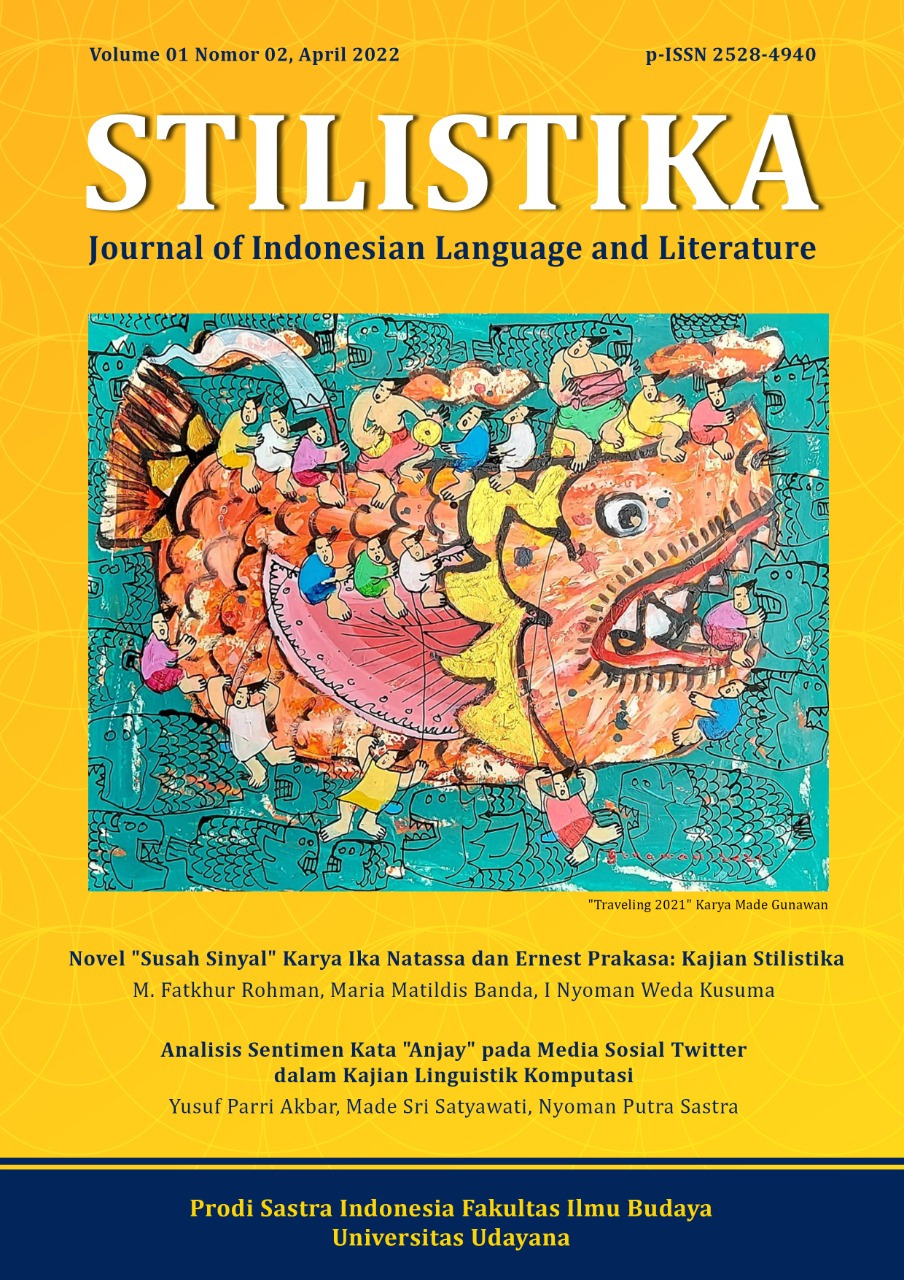Analisis Bentuk Metafora Lirik Lagu dalam Album Yang Patah Tumbuh, Yang Hilang Berganti Karya Banda Neira
Abstract
Humans express in two ways, namely verbal and nonverbal. Song is a form of nonverbal linguistic expression. Through songs, various meanings can be created from the beauty of its structure. One of the aesthetic elements in the song is metaphor. Based on this, this research is entitled "Analysis of the Metaphor Forms of Song Lyrics in the Album Yang Patah Tumbuh, Yang Hilang Berganti by Banda Neira”. The problems in this study are divided into two, 1) What kinds of metaphors are contained in the album Yang Patah Tumbuh, Yang Hilang Berganti by Banda Neira 2) What is the meaning of the metaphorical expression in the album Yang Patah Tumbuh, Yang Hilang Berganti by Banda Neira. The method used in this study is referential matching with the determining element sorting technique (PUP). The theory used is semantic theory related to metaphorical expressions according to Ullmann's point of view (2009). The results show that there are four forms of using metaphorical expressions for song lyrics in the album Yang Patah Tumbuh, Yang Hilang Berganti by Banda Neira. The four forms are (1) anthropomorphic metaphor (such as backs of grass and whispering leaves), (2) shapes metaphor from concrete to abstract (for example, everything is eternal, inevitable and natural), (3) animal metaphor (seeing the butterfly calling the wind), and (4) synaesthetic metaphor (blue for everything that is far away). This metaphorical expression can be interpreted as a vehicle for human reflection in carrying out daily life behaviors regarding the search for identity, hope-life balance, and the manifestation of self-contemplation.
Downloads
References
ClariS”. http://scholar.unand.ac.id/54055/. Diakses pada 27 September 2020.
Chaer, Abdul. 2009. Pengantar Semantik Bahasa Indonesia (Edisi Revisi). Jakarta: Rineka Citpa.
Djajasudarma, Fatimah. 1993. Semantik 1: Makna Leksikal dan Gramatikal. Bandung: PT Rafika Aditama.
Djajasudarma, Fatimah. 2006. Metode Linguistik: Ancangan Metode Penelitian dan Kajian. Bandung: PT Rafika Aditama.
Hermawan. 2017 Banda Neria: “Musik dan Ingatan di dalam Bui Tapol ’65” dalam https://www.sanskertaonline.id/ diakses 4 Agustus 2021.
Keraf, Gorys. 1984. Diksi dan Gaya Bahasa. Jakarta: PT Gramedia Pustaka Utama.
Keraf, Gorys. 2004. Komposisi: Sebuah Pengantar Kemahiran Bahasa. Ende: Nusa Indah. Keraf, Gorys. 2010. Diksi dan Gaya Bahasa. Jakarta: PT Ikrar Mandiri Abadi.
Kridalaksana, Harimurti. 2005. Kelas Kata dalam Bahasa Indonesia. Jakarta: PT Gramedia Pustaka Utama.
Kridalaksana, Hrimurti. 2001. Kamus Linguistik. Jakarta: PT Gramedia Pustaka Utama.
Latifah, Eka Nur. 2017. “Metafora dalam Album Lagu Unter Dem Eis Karya Eisblume”. https://eprints.uny.ac.id/46420/. Diakses 8 September 2020.
Magfirah, Nurul. 2019. “Metafora dalam Tajuk Rencana Pada Surat Kabar Haran Kompas Dan Fajar”. http://eprints.unm.ac.id/15113/. Diakses 3 Desember 2020.
Maharani, Nabilla. 2020. “Metafora dalam Wacana Berita Di Kedaulatan Rakyat Edisi 20 September 2019”. http://repository.usd.ac.id/36485/. Diakses 5 Desember 2020.
Moleh, Wandi. 2018. “Menelusuk Lirik Banda Neira”
dalam https://sayorpaku.blogspot.com/2018/10/menelusuk-lirik-banda-neira.html diakses 4 Agustus 2021.
Moleong, J. Lexy. 2000. Metodologi Penelitian Kualitatif. Bandung: PT Remaja Rosdakarya. Ratna, I Nyoman Kutha. 2004. Teori, Metode, dan Teknik Penelitian Sastra. Yogyakarta: Pustaka Pelajar.
Sudayanto, D. Edi. 1993. Metode dan Aneka Teknik Analisis Bahasa. Jakarta: Duta Wacana University Press.
Tarigan, Henry Guntur. 1985. Pengajaran Gaya Bahasa. Bandung: Angkasa.
Ullmann, Stephen. 2009. Pengantar Semantik. Yogyakarta: Pustaka Pelajar.
Wahab, Abdul. 1991. Isu Linguistik Pengajaran Bahasa dan Sastra. Surabaya: Airlangga University Press.
Wahyuningtyas, Widya. 2019. “Metafora dan Fungsi Metafora dalam Novel Garis Waktu Karya Fiersa Besari”. https://repository.usd.ac.id/35218/. Diakses pada 24 September 2020.






